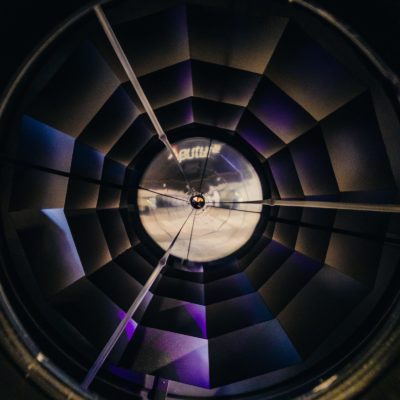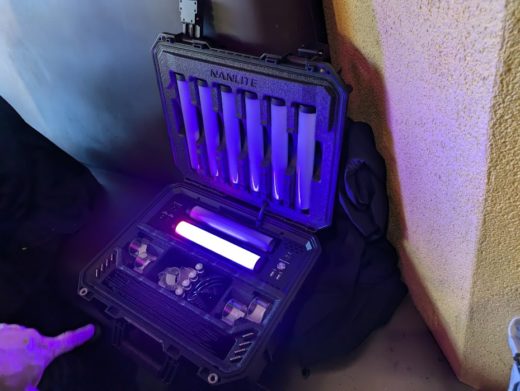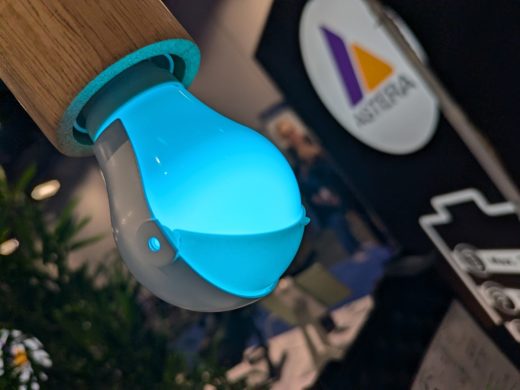
One of the incidental pleasures of a trade show like NAB is the option to wander the exhibits and enjoy the process of discovering new ideas which might be too specialist to make big headlines, but which seem likely to fill their niche to perfection.
Whether or not we consider a giant beam light to be an obscure, specialist piece of equipment is a matter of perspective, considering the results are probably visible from orbit if pointed in the right direction. Aputure’s new parabolic reflector is a development which earns mention here because it is specifically designed to overcome some of the issues with creating bright, efficient, near-parallel beams from high power LEDs, which are invariably made of large arrays of emitters. Called the Parabolic Beam 70, after its 70cm diameter, it immediately recalls the appearance of something like a Molebeam and is intended to create similar effects.
Clearly, doing that with any efficiency demands a large reflector, but the reality is actually a bit more subtle. Attempts to focus large-area light sources into tight beams suffer from a number of complicated problems in optical physics, and the new reflector has a two-stage Cassegrain layout to capture as many photons as possible and push them in a useful direction. This separates it from designs like the Molebeam itself as well as some competing options which lack that refinement and give up some efficiency on that basis (though we’ve not measured either under controlled conditions).
Blasting a smoking hole in the stage wall
The parallel beam reflector is intended to complement the company’s higher-power light sources, the CS15 and XT26 lights (it will work to a degree on the monster XT52, but isn’t quite as optimised, which is perhaps something of a blessing for anyone who’d like to avoid blasting a smoking hole into the stage wall). The company specifies a five-degree beam divergence, which is positively death-ray-class, and more than well-enough collimated to create all the dramatic shafts of light anyone could possibly want. Call “fire in the hole!” before switching on.
At the other end of the scale, Nanlux’s sister company Nanlite debuted a neat case full of its new PavoTube 6XR lights. The light itself is in the familiar pixel tube format and adds CRMX connectivity over the previous PavoTube 6C. So far, so tube light, but the 6XR is also an example of the modern tendency to make the carrying case into more than just a piece of luggage. This one facilitates carrying and charging.

Similar benefits attend something from Astera which has been seen at trade shows for half a year, but which we’ll sneak in here because it’s well done and good fun. The world contains a lot of LED lightbulbs, but there’s a sort of unspoken problem with a lot of them: they don’t actually look like lightbulbs. They’re often bigger, so as to be able to achieve higher output, or subtly the wrong shape, or half made of white plastic, and fail to really convince us that we’re really looking at a scene which was shot in some bygone age of hundred-watt tungsten.
At NAB 2025, Astera is showing a diminutive LED bulb designed to solve the problem and has clearly applied quite a bit of thought to getting it right. The concept apparently arose from James Friend, BSC, recipient of the Academy Award for Best Cinematography for his work on All Quiet on the Western Front. Whether or not Friend’s intervention is directly responsible for the attention to detail on show here isn’t clear, but Astera has made a lightbulb that’s not only the right size and shape, but even exhibits the slightly uneven illumination of a real filament coiled inside a glass vacuum envelope. At 3.5W apiece, they are not hugely powerful, but anyone looking to simulate something in the 40-60W range won’t go wrong.

The cutest options at NAB
There is, again, a case which can both charge and – unusually – control the lights individually or as a group. If there were one characteristic of Astera’s work which could reasonably be recommended to other manufacturers, though, it is that almost all of the company’s products use exactly the same LED emitters and colour mathematics, which means, within normal manufacturing tolerance, two Astera lights are more likely to match than competing options.

Cute as Astera’s bright ideas are (and they are plenty cute) our purpose here is to highlight some of the small-but-perfectly-formed bits of design work which crop up at shows like NAB but often don’t get as much attention as they probably deserve. For another case in point, consider Matthews Studio Equipment, purveyors of things that film students find boring until they get good enough at camerawork to realise they need to put a light in an inconvenient location. We won’t labour this point as Jose’s excellent preview of the Matthews exhibit includes all the relevant details.
Still, it is perhaps worth highlighting the dual air climber configuration, with two climbers rigged with truss to create a wide range of overhead rigging opportunities. It looms over the show floor as an unsubtle reminder that quite a lot of the filmmaking techniques of the last century or so remain fully relevant, even if we don’t all need giant self-extending lighting stands capable of supporting an 18K. Either way, someone from Matthews has hung a disco ball on that piece of truss which shines out across the NAB show floor, and that’s a good way to highlight a piece of equipment that might otherwise be unfairly dismissed as, well, ironmongery.

Filmtools
Filmmakers go-to destination for pre-production, production & post production equipment!
Shop Now













